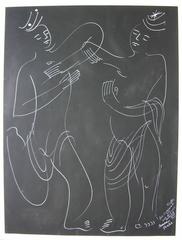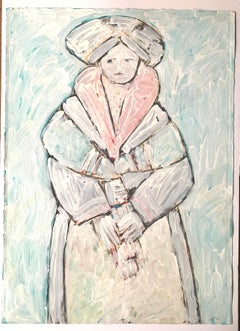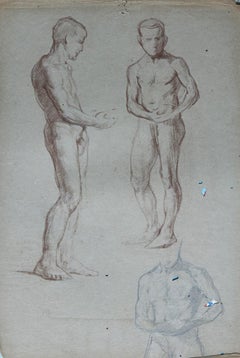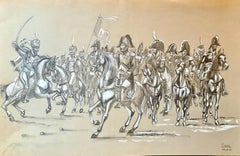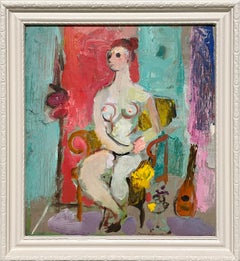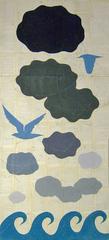Chalk Figurative Paintings
to
2
5
5
3
Overall Width
to
Overall Height
to
9
4
4
1
1
1
2
29
13
5
4
2
1
1
1
9
3
1
9
6
4
4
4
1
1
1
1
1
1
1
1
739
2,993
2,049
1,105
1,083
2
1
1
1
1
3
4
4
2
Style: Modern
Medium: Chalk
Portrait of a Parisian Woman
Located in London, GB
Nicolle was born in Zimbabwe (Rhodesia as it was then) and grew up in Africa and then travelled the world for some years before settling in the Uk.
“My love of colour stems from my ...
Category
2010s Modern Chalk Figurative Paintings
Materials
Chalk, Mixed Media, Acrylic
Frank Dobson Modern Drawing Female Nude
By Frank Dobson
Located in Roma, IT
Important red chalk drawing of a reclining Female nude
Signed and dated by Frank Dobson "Frank Dobson 37"
This drawing, never before on the market, comes from an important European...
Category
1930s Modern Chalk Figurative Paintings
Materials
Paper, Chalk
Untitled
Located in New York, NY
Chalk on black paper 1963. (Inscribed 1963) Signed and Dated.
I.Rice Pereira was an American abstract artist, poet, and philosopher who playe...
Category
1960s American Modern Chalk Figurative Paintings
Materials
Chalk
"Asian Woman II" American Modernist Figurative Painting Académie Julian
By Jack Hooper
Located in Arp, TX
Jack Hooper
"Asian Woman II"
10-1990
Acrylic and conte crayon on rag paper
31"x42.25 unframed
Signed and dated in pencil lower right
Minor wear consistent with age and history
Jac...
Category
1990s American Modern Chalk Figurative Paintings
Materials
Conté, Acrylic, Rag Paper
$1,800 Sale Price
40% Off
Royal Academy Series-7, Conte on Paper, Modern Artist Atul Bose "In Stock"
Located in Kolkata, West Bengal
Atul Bose - Royal Academy Series-6
Pencil on Paper, 15 x 11.2 inches (Unframed Size)
1924-26 (Delivered Unframed in as is condition)
Atul Bose was a master artist whose creative journey spanned several decades and left an indelible mark on the Indian art scene. He was born in 1898 in a small village in Bengal and showed an early aptitude for art. Despite facing financial difficulties, he pursued his passion and enrolled in the Government School of Art in Calcutta.
Bose's early works were influenced by the Bengal School of Art, which was a movement that sought to revive traditional Indian art forms. However, over time, Bose developed his own unique style that blended elements of Indian art with European modernism. He was particularly influenced by the works of artists like Paul Cezanne and Georges Braque.
Bose spent two years, 1924-6, at the Royal Academy. He was heavily influenced there by the post-impressionist Walter Sickert. He refused an invitation to help decorate the pavilion at the British Empire Exhibition in 1924 with Mukul Dey...
Category
1920s Modern Chalk Figurative Paintings
Materials
Paper, Conté, Ink, Pen, Pencil
Royal Academy Series-6, Pencil on Paper, Modern Artist Atul Bose "In Stock"
Located in Kolkata, West Bengal
Atul Bose - Royal Academy Series-6
Pencil on Paper, 15 x 11.2 inches (Unframed Size)
1924-26 (Delivered Unframed in as is condition)
Atul Bose was a master artist whose creative journey spanned several decades and left an indelible mark on the Indian art scene. He was born in 1898 in a small village in Bengal and showed an early aptitude for art. Despite facing financial difficulties, he pursued his passion and enrolled in the Government School of Art in Calcutta.
Bose's early works were influenced by the Bengal School of Art, which was a movement that sought to revive traditional Indian art forms. However, over time, Bose developed his own unique style that blended elements of Indian art with European modernism. He was particularly influenced by the works of artists like Paul Cezanne and Georges Braque.
Bose spent two years, 1924-6, at the Royal Academy. He was heavily influenced there by the post-impressionist Walter Sickert. He refused an invitation to help decorate the pavilion at the British Empire Exhibition in 1924 with Mukul Dey...
Category
1920s Modern Chalk Figurative Paintings
Materials
Paper, Ink, Pen, Conté, Pencil
Radha, Tempera Coloured Conte on Pastel on Paper by Artist Suhas Roy "In Stock"
By Suhas Roy
Located in Kolkata, West Bengal
Suhas Roy - Radha - 20 x 20 inches ( unframed size)
Tempera Coloured Conte on Pastel on Paper , 2005
Suhas Roy 's mystic woman which he calls 'Radha', either Oil on canvas or sof...
Category
Early 2000s Modern Chalk Figurative Paintings
Materials
Pastel, Board, Paper, Conté, Tempera
Head, Ink on Conte Paper, Black, Grey by Indian Artist Sunil Das "In Stock"
By Sunil Das
Located in Kolkata, West Bengal
Sunil Das - Head - 7 x 6 inches (unframed size)
Ink on Conte Paper
Inclusive of shipment in ready to hang form.
Sunil Das (1939-2015) was a Master Modern Indian Artist from Bengal. ...
Category
2010s Modern Chalk Figurative Paintings
Materials
Paper, Ink, Conté
"Asian Woman I" American Modernist Figurative Painting Académie Julian
By Jack Hooper
Located in Arp, TX
Jack Hooper
"Asian Woman I"
10-1990
Acrylic and conte crayon on rag paper
28"x42.25 unframed
Signed and dated in pencil lower right
Jack Meredith Hooper (August 26, 1928 - January ...
Category
1990s American Modern Chalk Figurative Paintings
Materials
Acrylic, Rag Paper, Conté
$1,800 Sale Price
40% Off
Royal Academy Series-4, Conte on Paper, Modern Artist Atul Bose "In Stock"
Located in Kolkata, West Bengal
Atul Bose - Royal Academy Series-4
Conte on Paper, 15 x 11.2 inches (Unframed Size)
1924-26 (Delivered Unframed in as is condition)
Atul Bose was a master artist whose creative journey spanned several decades and left an indelible mark on the Indian art scene. He was born in 1898 in a small village in Bengal and showed an early aptitude for art. Despite facing financial difficulties, he pursued his passion and enrolled in the Government School of Art in Calcutta.
Bose's early works were influenced by the Bengal School of Art, which was a movement that sought to revive traditional Indian art forms. However, over time, Bose developed his own unique style that blended elements of Indian art with European modernism. He was particularly influenced by the works of artists like Paul Cezanne and Georges Braque.
Bose spent two years, 1924-6, at the Royal Academy. He was heavily influenced there by the post-impressionist Walter Sickert. He refused an invitation to help decorate the pavilion at the British Empire Exhibition in 1924 with Mukul Dey...
Category
1920s Modern Chalk Figurative Paintings
Materials
Paper, Ink, Pen, Conté
Royal Academy Series-4, Conte on Paper, Modern Artist Atul Bose "In Stock"
Located in Kolkata, West Bengal
Atul Bose - Royal Academy Series-4
Conte on Paper, 15 x 11.2 inches (Unframed Size)
1924-26 (Delivered Unframed in as is condition)
Atul Bose was a master artist whose creative journey spanned several decades and left an indelible mark on the Indian art scene. He was born in 1898 in a small village in Bengal and showed an early aptitude for art. Despite facing financial difficulties, he pursued his passion and enrolled in the Government School of Art in Calcutta.
Bose's early works were influenced by the Bengal School of Art, which was a movement that sought to revive traditional Indian art forms. However, over time, Bose developed his own unique style that blended elements of Indian art with European modernism. He was particularly influenced by the works of artists like Paul Cezanne and Georges Braque.
Bose spent two years, 1924-6, at the Royal Academy. He was heavily influenced there by the post-impressionist Walter Sickert. He refused an invitation to help decorate the pavilion at the British Empire Exhibition in 1924 with Mukul Dey...
Category
1920s Modern Chalk Figurative Paintings
Materials
Paper, Ink, Pen, Conté
Babu, Charcoal and Conte on Paper, Brown Color by Lalu Prasad Shaw "In Stock"
Located in Kolkata, West Bengal
Lalu Prasad Shaw - Babu - 21 x 15 inches
Charcoal and Conte on Paper, 2011
(Unframed & Delivered)
Style : Known widely for his highly stylized portraits of Bengali women and couples...
Category
2010s Modern Chalk Figurative Paintings
Materials
Paper, Mixed Media, Conté, Charcoal
Statue of Liberty
By LeRoy Neiman
Located in Missouri, MO
LeRoy Neiman (American, 1921-2012)
Statue of Liberty, July 4, 1986
Signed and Dated Lower Left
Acrylic Paint and Chalk
24 x 16 inches
37.5 x 29.25 inches with frame
Mr. Neiman's ki...
Category
1980s American Modern Chalk Figurative Paintings
Materials
Chalk, Acrylic
Price Upon Request
Related Items
Napoleon at the Head of His Grande Armée, His Generals and the Prussian Hussars
Located in Cotignac, FR
Pencil, chalk and watercolour depiction of Napoleon at the head of his generals by French artist Jean Ducel. The work is signed bottom right.
A bold and graphic depiction of Napoleo...
Category
Late 20th Century Outsider Art Chalk Figurative Paintings
Materials
Chalk, Crayon, Cardboard, Pencil, Watercolor
A Fabulous 1950s Mid-Century Modern Seated Female Nude by Francis Chapin
Located in Chicago, IL
A Fabulous, 1950s Mid-Century Modern Studio Interior Scene of a Seated Female Nude Model by Famed Chicago Artist, Francis Chapin (Am. 1899-1965). Completed in the vibrant, Fauvist, ...
Category
Mid-20th Century American Modern Chalk Figurative Paintings
Materials
Masonite, Oil
$950
H 16.25 in W 18.25 in D 1 in
Mid Century Modern Dancers Oil Painting; Listed Artist Albert Michini, ca 1970’s
Located in Baltimore, MD
If you have an association with dance, yoga or working out, this unusual modernist painting might be an interesting addition to your space. Artist Albert Michini used several models ...
Category
1970s American Modern Chalk Figurative Paintings
Materials
Oil
"Sock Hop" Mid-Century American Modernism WPA Female Artist 20th Century Realism
By Kyra Markham
Located in New York, NY
"Sock Hop" Mid-Century American Modernism WPA Female Artist 20th Century Realism. 30 x 24 inches. Oil on canvas. Signed on stretcher, c. 1940s. Frame is likely original to the painting.
Realist painter-printmaker Kyra Markham...
Category
1940s American Modern Chalk Figurative Paintings
Materials
Canvas, Oil
$25,000
H 34 in W 28 in D 2 in
British Chalk Pencil Sketch of A Fisherman Preparing His Fly Fishing Rod
Located in Cirencester, Gloucestershire
John Rabone Harvey ( 1966 - 1922)
graphic and chalk deep green artist paper , unframed
artist paper : 7 x 5.5 inches
Provenance: private collection
Condition: very good condition
Ha...
Category
Mid-19th Century Realist Chalk Figurative Paintings
Materials
Chalk, Graphite
Mother and child, Signed painting on paper (unique), Hammer Galleries, Framed
By Gloria Vanderbilt
Located in New York, NY
Gloria Vanderbilt
Untitled mother and child painting
Gouache on paper
Signed by the artist on the front
Frame included
A poignant painting of a mother and child from the 1960s. Whi...
Category
1960s Modern Chalk Figurative Paintings
Materials
Mixed Media, Acrylic, Gouache, Permanent Marker
Greco Roman Classical Wrestlers Oil Painting
Located in Rochester, NY
Late 20th century modernist oil painting of Greco Roman wrestlers done in the classical style. By David Loeb. Oil on handmade paper. Signed on reverse and dated 1989.
Loeb was born in 1953 and raised in Chappaqua, New York, David Loeb’s mother and her identical twin were painters, and he has been painting since childhood. He studied with Gillian Pederson-Krag at Cornell University; Reed Kay at Boston University; Louis Finkelstein, Wolf Kahn and Philip Guston at the Yale Summer School of Art and Music; and attended graduate school at Indiana University, Bloomington, where he studied with Robert Barnes...
Category
20th Century Modern Chalk Figurative Paintings
Materials
Oil, Handmade Paper
The Artist's Wife oil painting by Hans Burkhardt
Located in Hudson, NY
Hans Burkhardt
The Artist's Wife (1930)
Oil on canvas, 20" x 16"
24" x 20 ½" x 1 ½" framed
Dated 1930 lower right recto. Annotated "To Elsa HB Louise Burkhardt 1930. HB" verso.
...
Category
1930s American Modern Chalk Figurative Paintings
Materials
Canvas, Oil
Stylish Hawaiian Luau Oil Painting by Listed artist Mario Larrinaga (1895-1979)
Located in Baltimore, MD
Mario Larrinaga was born in Baja California in 1895 and moved with his brother to Los Angeles in 1909. He had no formal training in art, but had natural talent that was noticed by local movie studios. He was hired by Universal Studios as a designer, art director and creator of background scenes. He produced some of the background effects for King Kong in 1933. After a career in set design and illustration he focused on painting for pleasure in California, Mexico and Hawaii. He belonged to local art clubs and exhibited his works often.
This stylized modernist work was likely created around 1960. It is oil on wood panel and of a horizontal format, 18” x 36”. It portrays a procession of seemingly Hawaiian natives...
Category
Mid-20th Century American Modern Chalk Figurative Paintings
Materials
Oil
$1,650
H 18 in W 36 in D 2 in
Wonderfully Stylized, 60s Mid-Century Modern Oil of Standing Male Ballet Dancers
Located in Chicago, IL
A Wonderfully Stylized, 60s Mid-Century Modern Oil Painting of Standing Male Ballet Dancers by Noted Chicago Artist, Rudolph T. Pen. Painted in the 1960s, this captivating dance stu...
Category
Mid-20th Century American Modern Chalk Figurative Paintings
Materials
Canvas, Oil
$1,200
H 25 in W 17 in D 2 in
Bathers, Modernist Nudes, Oil on Canvas, Signed and Titled
By Leon Kelly
Located in Doylestown, PA
"Bathers" by Philadelphia born modernist painter Leon Kelly, is a fantasy nude scene of two female figures, one with towel in hand, one only depicted as a portrait within the paintin...
Category
20th Century American Modern Chalk Figurative Paintings
Materials
Canvas, Oil
$4,125 Sale Price
44% Off
H 21 in W 25 in D 2 in
"Tighties" 1950's Gouache Male Nude Mid Century Painting
By Jerry Opper
Located in Arp, TX
From the estate of Jerry Opper & Ruth Friedman Opper
Tighties
c. 1950's
Gouache on Paper
15" x 18" blue lacquered frame 18.5"x1.75"x21.5"
Unsigned
From the estate of Ruth Friedmann Opper & Jerry Opper. Ruth was the daughter of Bauhaus artist, Gustav Friedmann...
Category
Mid-20th Century Modern Chalk Figurative Paintings
Materials
Paper, Gouache
Previously Available Items
Two Reclining Nudes - Modern Figurative Abstract
Located in Soquel, CA
Modern abstract figurative with two nude figures in neutrals and red reclining against a black and tan background by Alex Cruz (American, 20th Century). Sign...
Category
Late 20th Century American Modern Chalk Figurative Paintings
Materials
Conté, Acrylic
The Forms of Water in Clouds & Rivers with Bluebirds (Chalk Drawing on Paper)
Located in Hudson, NY
chalk on vintage collaged book pages.
Artwork measures 72 x 31.5 inches,
76.5 x 35.5 inches framed, deckle edge paper is floated in natural wood moulding with glass.
This work on pa...
Category
2010s Modern Chalk Figurative Paintings
Materials
Paper, Chalk
H 76.5 in W 35.5 in D 2 in
"PROJECT FOR VICTORY JOE-MANILA"
Located in Los Angeles, CA
JOHN W. HATCH
"PROJECT FOR VICTORY JOE-MANILA"
CHARCOAL AND CHALK ON BOARD, ESTATE STAMPED
AMERICAN, C.1947
20 X 30 INCHES
John Woodsum Hatch
1919-1998
This is a c...
Category
1940s American Modern Chalk Figurative Paintings
Materials
Chalk, Charcoal
Chalk figurative paintings for sale on 1stDibs.
Find a wide variety of authentic Chalk figurative paintings available on 1stDibs. While artists have worked in this medium across a range of time periods, art made with this material during the 21st Century is especially popular. If you’re looking to add figurative paintings created with this material to introduce a provocative pop of color and texture to an otherwise neutral space in your home, the works available on 1stDibs include elements of purple, orange, yellow and other colors. There are many well-known artists whose body of work includes ceramic sculptures. Popular artists on 1stDibs associated with pieces like this include Howard Tangye, Sanatan Dinda, Jack Hooper, and Joseph Piccillo. Frequently made by artists working in the Contemporary, Modern, all of these pieces for sale are unique and many will draw the attention of guests in your home. Not every interior allows for large Chalk figurative paintings, so small editions measuring 0.1 inches across are also available


